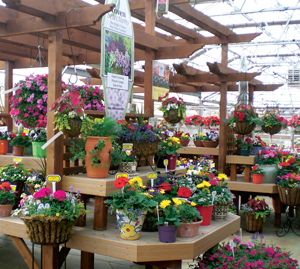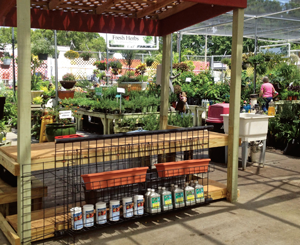April 6, 2016
Spring 2016 is now!
YOUR CHOICE: Plan now, or settle for lower revenue
For the record, the Vernal Equinox for 2016 is March 19. Read: First Day of Spring.
One of the sentences I hear most often in my work with store development customers is, “Spring just slipped up on us.” Given the absolute predictably of the date of the vernal equinox (not just for the following year, but for centuries into the future), this phrase can be translated as, “We just didn’t get it done.” That store development project that seemed so exciting and doable in August, September or October somehow got back-burnered into yet another year of, “We ran out of time.”

In the current retail environment, where mass merchandisers continue to take market share, and enthusiasm for gardening has shifted to edibles, organics and container gardening, letting spring slip up on you (again) could be disastrous.
I admit there’s a lot of work to be done just to get plant material and other products ready for spring. But, if your store isn’t ready, that product is likely to languish into either a pile of ‘shrink’ or into another year of repacking boxes for storage. Both ‘shrink’ and repacking up unsold merchandise leaves money on the table that you can never recoup.
So, Spring 2016 is NOW. Start by making a big poster for your office and the break room that proclaims the date of your planned grand opening next spring, and your projected sales increase for 2016, in bright red bold letters. Put it in writing and it becomes real. Or, in the words of Henry David Thoreau, “Humans tend to hit what they aim at.” So take aim at Spring 2016. Purchase a monthly planning calendar for 2016 or make your own store development notebook with monthly objectives. Put everything in one storage calendar or notebook. No loose pieces of paper.
Once you have the date, the sales objective and a planning workbook, here are the store development projects that you must put on the calendar:
Eliminate aged-out inventory. Many experts will tell you 80 per cent of sales come from 20 per cent of the freshest merchandise. Evaluate every non-plant item that has been in inventory more than a year, and make a liquidation plan now. Decide what goes on the sale table. Decide what you will do with stuff that has been on the sale table for three months or more. Plan an “Aged to Imperfection” sale and put everything over a year old on one big table for ridiculously low prices. If you have Christmas ornaments or other small geegaws, give one to every kid who comes to the store. Anything still in the store in two months goes to charity. Just do it. As you eliminate these items, note what NOT TO BUY when you go to the gift mart or trade shows this fall.
Don’t have a sale table? Create one now, and make sure your customers know about it. Place sale areas deep in the store. Creating a year-round sale area can help eliminate our industry’s unique practice of putting the whole store on sale once a year. Ask yourself what that practice teaches your customers. Some stores even brand this department: Lemons and Leftovers or Aged to Imperfection or your own idea.
 Evaluate vendors. Take a good look at the vendors you work with to find those who are partners, and those who are order takers. You need all the help you can get, and your suppliers should be first-responders to that need. Contact each vendor to alert them you have already begun your planning. What products or services do your vendors offer that can help you get ready for spring? Who has POPs? Which vendors will come to your store to help with product set-up or be on-site during busy days to manage their product? Ask for training programs for your staff. Product knowledge is key to selling. Organize those dates now, before the store down the street takes the limited time salespeople may have to allocate in-store visits.
Evaluate vendors. Take a good look at the vendors you work with to find those who are partners, and those who are order takers. You need all the help you can get, and your suppliers should be first-responders to that need. Contact each vendor to alert them you have already begun your planning. What products or services do your vendors offer that can help you get ready for spring? Who has POPs? Which vendors will come to your store to help with product set-up or be on-site during busy days to manage their product? Ask for training programs for your staff. Product knowledge is key to selling. Organize those dates now, before the store down the street takes the limited time salespeople may have to allocate in-store visits.Evaluate product categories. The number one complaint from younger consumers is a confusing array of choices. Eliminate plants that didn’t sell. Then, decide on the best tomato, the best red petunia, the best four Heuchera, the best new introductions. Eliminate everything that isn’t the one (or two) best. Ninety per cent of your customers want to grow one good tomato, not 35 heirlooms. Have you looked at the new grafted tomato/potato named Ketchup and Fries? Focus on container gardening in all its forms: traditional containers, hanging baskets, interior containers, wall gardens, raised beds and window boxes. For many stores, container gardening is the fastest growing category. Maybe you need to create a space in the store to showcase your container offering.
Get your team together over pizza and review all the Big Plans you’ve floated over the past five years for store improvement. Collect all the brainstorming on a big easel tablet. Then, form a three-person store development team to establish priorities and evaluate budgets. You can’t do what you can’t afford. But, a new bathroom won’t break the budget and might just give your entire store a boost. If you don’t have one, create a store site plan. Use a simple 1-in. = 10 ft. scale on graph paper, and map everything from the parking lot to the loading dock. (No loading dock? Where should it be?) Next, get your staff together and ask this question: “Where do customers shop and where do we want them to shop?” Your staff is a wealth of knowledge about store issues. They know where the dead areas are, and where the congestion happens. You will be amazed at the insight from the mixture of a site plan and staff eyes. Photograph the store from the customers’ encounter points. If you really want to see your store in ways you cannot, when you are in it every day for years, photograph the store beginning at the point on the road when the customer first spots your entrance. Then begin in the parking lot and photograph every view the customer has of the store. You’ll see the clutter and the ‘obstructures’ through new eyes — your customer’s eyes.
Still not sure about Spring 2016?
HEAR JUDY SHARPTON IN PERSON
 Sept. 9 CANWEST, Abbotsford, B.C.
Sept. 9 CANWEST, Abbotsford, B.C.Join Judy for Merchandising that Sells, a half-day
interactive workshop that adapts merchandising concepts
from larger sectors to garden centre retailers.
Learn how to adapt to your customers’ demographics,
focus their attention to your highest-margin products and encourage
add-on sales. Register at canwesthortexpo.com.
Sept. 16 GARDEN EXPO, Ancaster, Ont.
Judy is keynote speaker at the Retailers’ Breakfast,
where she will challenge the ubiquitous black nursery pot,
and offer alternative packaging that will change the
retail environment — and possibly your customer’s perception
of your store. Garden Expo is part of Thrive’15, Landscape Ontario’s new fall event.
Purchase tickets at lothrive.com.
Judy Sharpton has been helping garden centres renovate and redesign for over 20 years. She is a popular presenter at green industry retail events across North America.